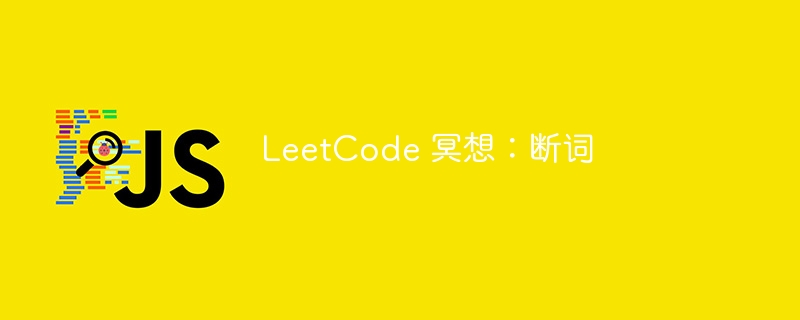LeetCode 冥想:断词
来源:dev.to
时间:2024-12-06 14:37:02 475浏览 收藏
目前golang学习网上已经有很多关于文章的文章了,自己在初次阅读这些文章中,也见识到了很多学习思路;那么本文《LeetCode 冥想:断词》,也希望能帮助到大家,如果阅读完后真的对你学习文章有帮助,欢迎动动手指,评论留言并分享~

此问题的描述是:
给定一个字符串 s 和一个字符串字典 worddict,如果 s 可以分割成一个或多个字典单词的空格分隔序列,则返回 true。
注意词典中的同一个单词可能会在分词中重复使用多次。
例如:
input: s = "leetcode", worddict = ["leet", "code"] output: true explanation: return true because "leetcode" can be segmented as "leet code".
或者:
input: s = "applepenapple", worddict = ["apple", "pen"] output: true explanation: return true because "applepenapple" can be segmented as "apple pen apple". note that you are allowed to reuse a dictionary word.
或者:
input: s = "catsandog", worddict = ["cats", "dog", "sand", "and", "cat"] output: false
此外,我们的约束表明worddict 的所有字符串都是**唯一**,并且:
- 1 <= s.length <= 300
- 1 <= worddict.length <= 1000
- 1 <= worddict[i].length <= 20
- s 和 worddict[i] 仅由小写英文字母组成。
继续动态编程解决方案,我们可以看看一种流行的自下而上的方法,我们构建一个 dp 数组来跟踪是否可以在每个索引处将 s 分解为 worddict 中的单词。
每个索引我 dp 数组中将指示是否可以将整个字符串分解为从索引开始的单词 我 .
| note |
|---|
| dp needs to be of size s.length 1 to hold the edge case of an empty string, in other words, when we're out of bounds. |
让我们用最初的错误值来创建它:
let dp = array.from({ length: s.length + 1 }, () => false); // +1 for the base case, out of bounds
最后一个索引是空字符串,可以认为它是可破坏的,或者换句话说,有效的:
dp[s.length] = true; // base case
向后看,对于 s 的每个索引,我们可以检查从该索引开始是否可以到达 worddict 中的任何单词:
for (let i = s.length - 1; i >= 0; i--) {
for (const word of worddict) {
/* ... */
}
}
如果我们仍在 s (i word.length <= s.length) 的范围内并且找到了单词 (s.slice(i, i word.length) === word),我们'将该槽标记为我们可以打破字符串的“下一个位置”的真值,这将是 i word.length:
for (let i = s.length - 1; i >= 0; i--) {
for (const word of worddict) {
if (i + word.length <= s.length && s.slice(i, i + word.length) === word) {
dp[i] = dp[i + word.length];
}
/* ... */
}
}
如果我们可以将其分解为worddict中的任何单词,我们就不必继续查看其他单词,因此我们可以跳出循环:
for (let i = s.length - 1; i >= 0; i--) {
for (const word of worddict) {
if (i + word.length <= s.length && s.slice(i, i + word.length) === word) {
dp[i] = dp[i + word.length];
}
if (dp[i]) {
break;
}
}
}
最后,我们返回 dp[0] - 如果整个字符串可以分解为 worddict 中的单词,则其值将存储 true,否则为 false:
function wordbreak(s: string, worddict: string[]): boolean {
/* ... */
return dp[0];
}
而且,这是最终的解决方案:
function wordBreak(s: string, wordDict: string[]): boolean {
let dp = Array.from({ length: s.length + 1 }, () => false); // +1 for the base case, out of bounds
dp[s.length] = true; // base case
for (let i = s.length - 1; i >= 0; i--) {
for (const word of wordDict) {
if (i + word.length <= s.length && s.slice(i, i + word.length) === word) {
dp[i] = dp[i + word.length];
}
if (dp[i]) {
break;
}
}
}
return dp[0];
}
时间和空间复杂度
时间复杂度为 o(n*m*t) 在哪里 n 是字符串 s, 米 是 worddict 中的单词数,并且 t 是 worddict 中的最大长度单词 - 因为我们有一个嵌套循环,通过切片操作遍历 worddict 中的每个单词,该切片操作使用 s 中每个字符的 word.length。
空间复杂度为 o(n) 因为我们为 s 的每个索引存储 dp 数组。
该系列中的最后一个动态规划问题将是最长递增子序列。在那之前,祝您编码愉快。
终于介绍完啦!小伙伴们,这篇关于《LeetCode 冥想:断词》的介绍应该让你收获多多了吧!欢迎大家收藏或分享给更多需要学习的朋友吧~golang学习网公众号也会发布文章相关知识,快来关注吧!
-
502 收藏
-
501 收藏
-
501 收藏
-
501 收藏
-
501 收藏
-
461 收藏
-
337 收藏
-
421 收藏
-
325 收藏
-
145 收藏
-
129 收藏
-
418 收藏
-
470 收藏
-
485 收藏
-
199 收藏
-
160 收藏
-
354 收藏
-

- 前端进阶之JavaScript设计模式
- 设计模式是开发人员在软件开发过程中面临一般问题时的解决方案,代表了最佳的实践。本课程的主打内容包括JS常见设计模式以及具体应用场景,打造一站式知识长龙服务,适合有JS基础的同学学习。
- 立即学习 543次学习
-

- GO语言核心编程课程
- 本课程采用真实案例,全面具体可落地,从理论到实践,一步一步将GO核心编程技术、编程思想、底层实现融会贯通,使学习者贴近时代脉搏,做IT互联网时代的弄潮儿。
- 立即学习 516次学习
-

- 简单聊聊mysql8与网络通信
- 如有问题加微信:Le-studyg;在课程中,我们将首先介绍MySQL8的新特性,包括性能优化、安全增强、新数据类型等,帮助学生快速熟悉MySQL8的最新功能。接着,我们将深入解析MySQL的网络通信机制,包括协议、连接管理、数据传输等,让
- 立即学习 500次学习
-

- JavaScript正则表达式基础与实战
- 在任何一门编程语言中,正则表达式,都是一项重要的知识,它提供了高效的字符串匹配与捕获机制,可以极大的简化程序设计。
- 立即学习 487次学习
-

- 从零制作响应式网站—Grid布局
- 本系列教程将展示从零制作一个假想的网络科技公司官网,分为导航,轮播,关于我们,成功案例,服务流程,团队介绍,数据部分,公司动态,底部信息等内容区块。网站整体采用CSSGrid布局,支持响应式,有流畅过渡和展现动画。
- 立即学习 485次学习
